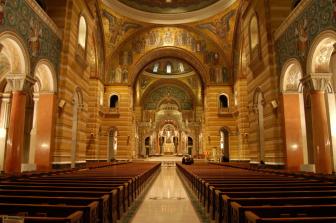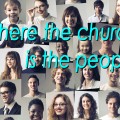 If you examine the New Testament and church history, it is clear that there is no one “right” form of the church. Part of the church’s sustaining power and the mystery of it’s effectiveness is its ability to morph its form to reach a culture. There are several forms of the church that are present in North America today and we’re going to look at them to help us at NineSevenZero Church know who we are and how we fit into the tapestry of the greater church in our culture.
If you examine the New Testament and church history, it is clear that there is no one “right” form of the church. Part of the church’s sustaining power and the mystery of it’s effectiveness is its ability to morph its form to reach a culture. There are several forms of the church that are present in North America today and we’re going to look at them to help us at NineSevenZero Church know who we are and how we fit into the tapestry of the greater church in our culture.
Centralized – The church as an event
Many North American churches function as a centralized weekly assembly of people meeting for an hour or two each week to be inspired to grow spiritually through teaching and worship. Personal interactions within the congregation during these meetings are minimal since the time is highly structured, and the service and the physical space make it difficult to connect in more than a superficial way. Outsiders are generally welcomed but they usually find it difficult to connect relationally unless they have family or friends already there. This form affords greater control by the professional clergy and helps maintain control of praxis. It is designed to best satisfy consumer Christians and places low expectations on members and attenders. The physical church building often become the central focus of not only the gatherings of the church but also it’s ministries and outreaches.
Distributed – The church with small groups
This form of the church includes the weekly centralized event but adds the dimension of small groups. Some members of the church meet regularly in smaller groups for closer community, bible study, and/or to serve together. Evangelistic efforts still focus on getting people to the centralized meeting and most new members of small groups come from the centralized service. These churches have small groups but they are not part of the DNA of the church and the small groups appear both inside and outside the church as another program or ministry of the church. This means that for outsiders to experience the community of the small group they must usually first attend and connect to the centralized service. This form also tends to create a church within the church, those in small groups within the larger congregation that attends the centralized services.
Decentralized – The church as a small group
The house church movement is an example of this form. It is a modern attempt to get away from the institutional centralized church, seeking instead to return to the small gatherings of peoples that constituted the churches of the New Testament. It posits that the centralized institutional church tends toward viewing its members as an audience and the worship experience as a performance. The home church instead seeks to view God as the audience and all the people equally engaged in worship. House church advocates reject any human authority other than the very real and present rule of Christ and due to their lack of trained clergy can easily fall into heresy. There are many examples of this happening in the New Testament. A good portion of the epistles address the heresies in various New Testament churches and they were all house churches. It is difficult for outsiders to locate and connect with this form of the church unless the church is very active in the local community. This form expects high levels of accountability and conformity for those that identify with the house church in that it functions much like an extended family.
Networked – The church as a community
This form emphasizes small groups as the relational and community forming unit of the church, However, the church does gather the small groups regularly with the purpose of corporate worship, prayer, and the preaching of the Word. These gatherings also feature testimonies of those working out their faith in community and the impact of the ministry of the small groups. The small groups become the primary vehicle for discipleship in the church, the means for care and nurture within the church, and the context for the ministry and mission of the church. Outsiders tend to connect to this church through the small groups first. They are attracted to the genuine relationships and meaningful service found in the small groups. The vocational clergy tends to focus on training the laity and facilitating their ministry and service.
Viral – The church infecting its world
This form looks similar to the Networked church structurally but it’s focus is not on creating a “Christian community” but rather to “be” the church, revealing Christ in word and life, to the people of their local community and the world. The Scriptural picture of this form of the church is as “salt,” “light,” or “a city on a hill.” The idea here is that each believer has been infected by Christ and that they are compelled to share their “new life” with those in their family, neighborhoods, schools, hangouts, and workplaces. Relationships with outsiders form naturally within their context, allowing them to experience the church in the spheres of their life. This missional form of the church contextualizes the gospel, packages it in the people of God, and sends them out to those living apart from God. This type of church recognizes the priesthood of all believers, the universal call of the Great Commission, and each believer’s role as an ambassador of the Kingdom to the culture around them and the world.
While there is a place and a need for churches of all forms, it is our desire for NineSevenZero Church to be viral and all of us who are a part of it to intentionally pass on that which has infected us. But for this contagion to spread we must;
- be disbursed in our culture,
- inoculate more carriers, and
- develop more transport methods.




0 Comments